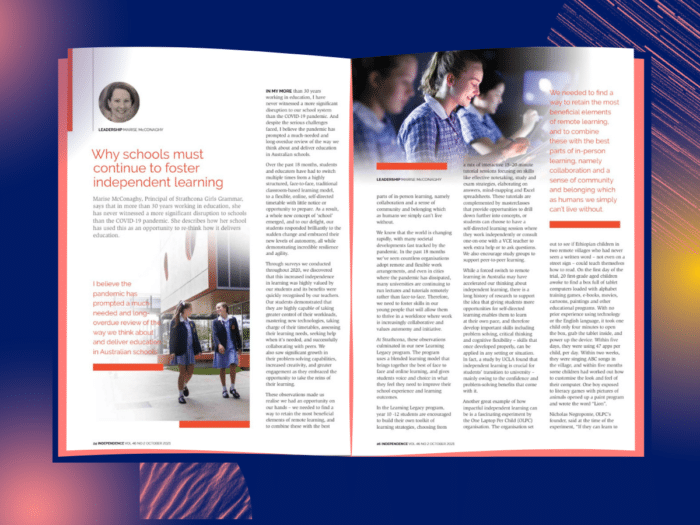In the Media: Independence Magazine, October 2021, By Marise McConaghy, Principal at Strathcona Girls Grammar
In my more than 30 years working in education, I have never witnessed a more significant disruption to our school system than the COVID-19 pandemic. And despite the serious challenges faced, I believe the pandemic has prompted a much-needed and long-overdue review of the way we think about and deliver education in Australian schools.
Over the past 18 months, students and educators have had to switch multiple times from a highly structured, face-to-face, traditional classroom-based learning model, to a flexible, online, self-directed timetable with little notice or opportunity to prepare. As a result, a whole new concept of ‘school’ emerged, and to our delight, our students responded brilliantly to the sudden change and embraced their new levels of autonomy, all while demonstrating incredible resilience and agility.
Through surveys we conducted throughout 2020, we discovered that this increased independence in learning was highly valued by our students and its benefits were quickly recognised by our teachers. Our students demonstrated that they are highly capable of taking greater control of their workloads, mastering new technologies, taking charge of their timetables, assessing their learning needs, seeking help when it’s needed, and successfully collaborating with peers. We also saw significant growth in their problem-solving capabilities, increased creativity, and greater engagement as they embraced the opportunity to take the reins of their learning.
These observations made us realise we had an opportunity on our hands – we needed to find a way to retain the most beneficial elements of remote learning, and to combine these with the best parts of in-person learning, namely collaboration and a sense of community and belonging which as humans we simply can’t live without.
We know that the world is changing rapidly, with many societal developments fast tracked by the pandemic. In the past 18 months we’ve seen countless organisations adopt remote and flexible work arrangements indefinitely, and even in cities where the pandemic has dissipated, many universities are continuing to run lectures and tutorials remotely rather than face-to-face. Therefore, we need to foster skills in our young people that will allow them to thrive in a workforce where work is increasingly completed independently and collaboration happens in-person.
At Strathcona, these observations culminated in our new Learning Legacy program. The program uses a blended hybrid learning model that brings together the best of remote, continuous and classroom learning, and gives students voice and choice in what they feel they need to improve their school experience and learning outcomes.
In the Learning Legacy Program, Year 10 -12 students are encouraged to build their own toolkit of learning strategies, choosing from a mix of interactive 15–20-minute tutorial sessions focusing on skills like effective notetaking, study and exam strategies, elaborating on answers, mind-mapping and Excel spreadsheets. These tutorials are complemented by masterclasses that provide opportunities to drill down further into concepts, or students can choose to have a self-directed learning session where they work independently or consult one-on-one with a VCE teacher to seek extra help or to ask questions. We also encourage study groups to support peer-to-peer learning.
While a forced switch to remote learning in Australia may have accelerated our thinking about independent learning, there is a long history of research to support the idea that giving students more opportunities for self-directed learning enables them to learn at their own pace, and therefore develop important skills including problem solving, critical thinking and cognitive flexibility – skills that once developed properly, can be applied in any setting or situation. In fact, a study by UCLA found that independent learning is crucial for students’ transition to university – namely owing to the confidence and problem-solving benefits that come with it.
Another great example of how impactful independent learning can be is a fascinating experiment by the One Laptop Per Child (OLPC) organisation. The organisation set out to see if Ethiopian children in two remote villages who had never seen a written word – not even on a street sign – could teach themselves how to read. On the first day of the trial, 20 first-grade aged children awoke to find a box full of tablet computers loaded with alphabet training games, e-books, movies, cartoons, paintings and other educational programs. With no prior experience using technology or the English language, it took one child only four minutes to open the box, grab the tablet inside, and power up the device. Within five days, they were using 47 apps per child, per day. Within two weeks, they were singing ABC songs in the village, and within five months some children had worked out how to customise the look and feel of their computer. One boy exposed to literacy games with pictures of animals opened up a paint program and wrote the word “Lion”.
Nicholas Negroponte, OLPC’s founder, said at the time of the experiment, “If they can learn to read, then they can read to learn”. This statement still rings true today and carries an important reminder for educators – if we can teach students to learn, then they can learn to do anything. By teaching students ‘how to learn’, we’re equipping them with the skills to navigate challenges and troubleshoot issues in their future careers and lives more generally.
Remote learning has also recalibrated our view of teachers, so that rather than ‘knowledge delivery systems’, we see them as facilitators, guides and mentors who help students to manage their own knowledge. And while digital technologies will continue to play a bigger role in schools of the future, they will by no means replace teachers. Rather, the role of the teacher is vital in realising the potential of these technologies and the increased independence they can enable.
This is not to say that I support or want a return to remote learning, which is not the same as independent learning. In fact, one of our most important observations during the pandemic has been that our students are incredibly social creatures. Face-to-face contact, collaboration and play are crucial for building emotional intelligence and fostering a sense of belonging and community. Rather, an education that encourages students to both grapple independently with problems and to think creatively, while also enabling group collaboration and community learning, will provide them with the best opportunity to succeed in their tertiary studies and future careers.
I am fully aware that the majority of teachers, principals and education staff are exhausted and likely yearning for normalcy and what we know, but it would be remiss of us to not use this opportunity to analyse and discuss which systems and practices implemented (even if not by choice) during this extraordinary time have actually enhanced the learning experience, and to apply these to our schools and curriculum if we’re to properly equip the next generation for life beyond the school gates.


